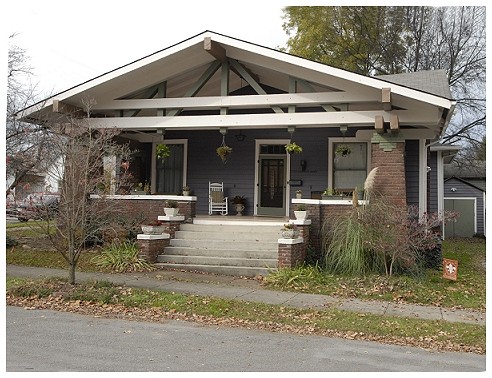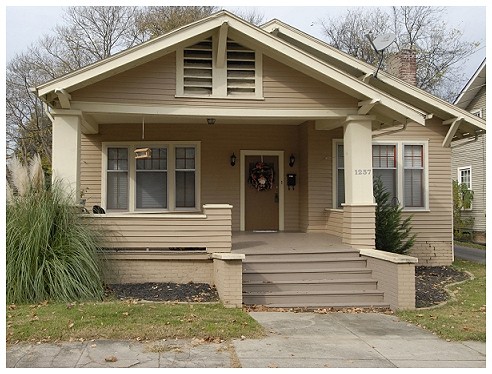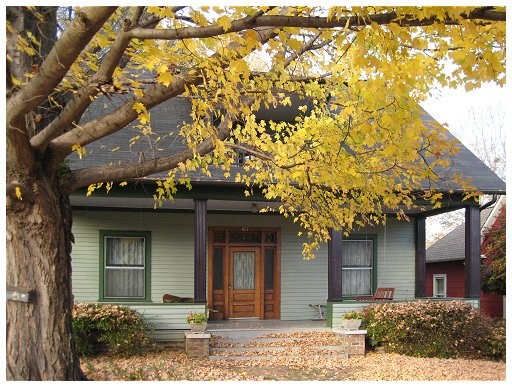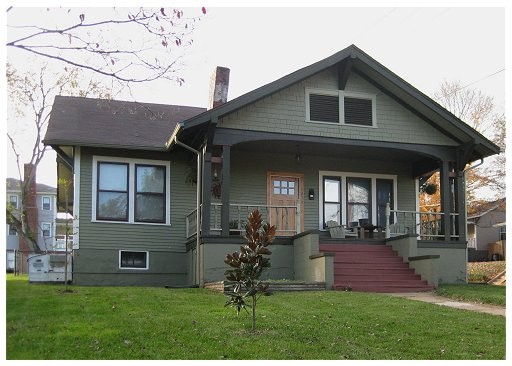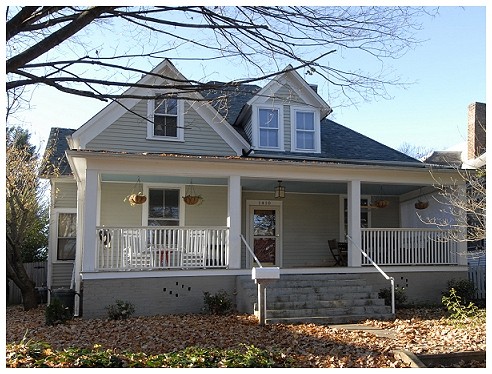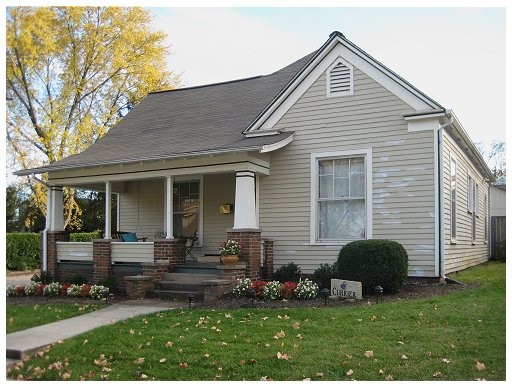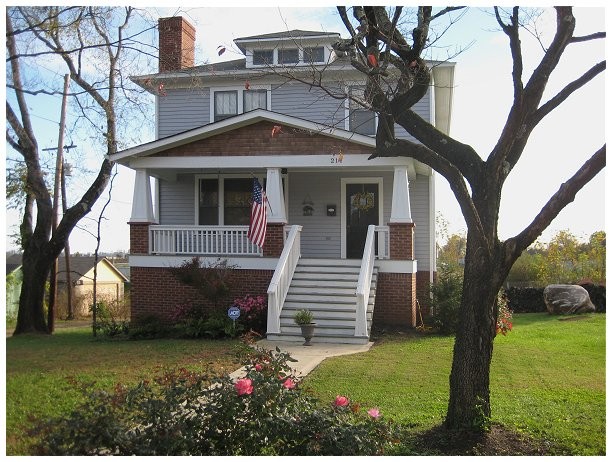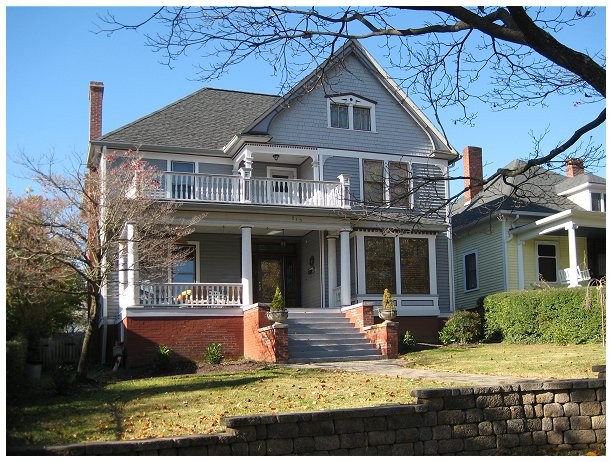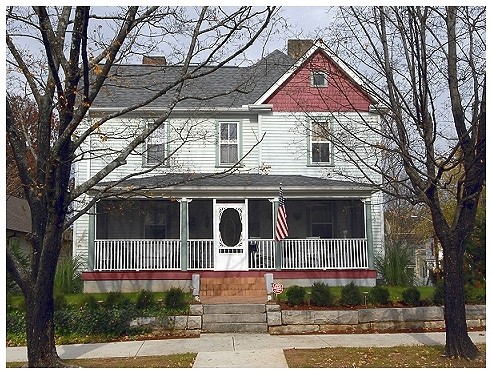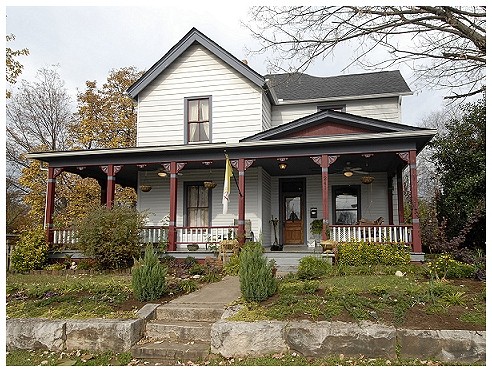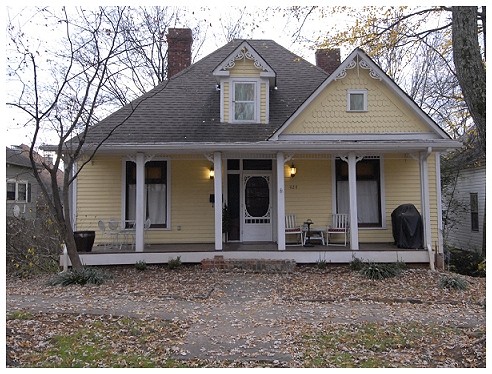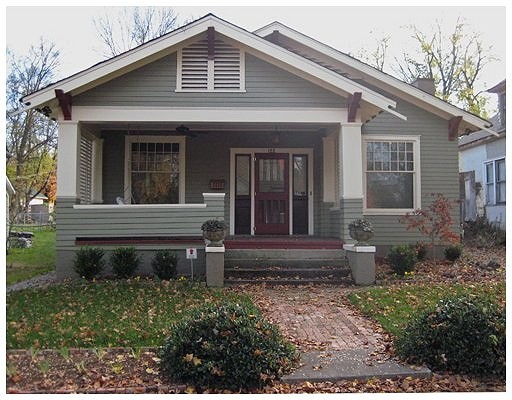1233 Armstrong Avenue
The house at 1233 Armstrong was built in the late 1800s and is typical of the Craftsman style found in so many of Old North’s early 20th century houses. The Craftsman style evolved as a reaction to the elaborate wood trim and curved shapes of the Victorian-era styles, and houses built in this style show heavy, sawn wood trim that mimics the structural supports usually hidden behind the walls. At this house, a king post, knee braces and exposed rafters appear to support the roof with its one story front porch. Short brick columns with cross-braced capitals and a brick balustrade compliment the brick foundation and the weatherboard wall covering.
The house has undergone many renovations to keep its traditional craftsman influence. Most recently, the kitchen has been remodeled with upgraded appliances and reworked for additional counter space and a more “spacious” feel. The house has hardwood flooring throughout (both oak and pine wood) and recently the floors in the kitchen, hallways, and butler pantries have been refinished. Future renovation plans include upgrading the current bathroom, adding an additional bathroom, and refinishing the rest of the hardwood flooring.
1237 Armstrong Avenue
This Craftsman style house was built around 1898. The one story frame building with weatherboard wall covering is distinguished by its front-facing gable roof with telescoping front gables. A one story front porch with a front gable roof marks the entry and provides outdoor living space, as was the tradition in houses of this style and era. Large square porch posts and wood louvered attic vents in the front porch gable, together with the brick chimney, provide architectural accents. The interior features an unusual ceramic tile fireplace and a wooded mountain scene carved into the tile above the mantle. Working pocket doors separate the dining and living rooms.
127 Leonard Place
This 1890 Craftsman Bungalow shows some details that are typical of Shingle style houses. The steeply pitched side gable roof and exposed rafter tails, the shed roofed dormer and second story sleeping porch, and the four over one and one over one windows are clearly Craftsman. Shingle style elements include the shingled wall covering on the second story, the square fluted posts with Doric capitals on the front porch and the leaded transom and sidelights.
The home’s interior features oak mantles, Victorian grain painted columns and trim, a dish pantry salvaged from a home in Fort Sanders, stained glass windows imported from England, a library with floor-to-ceiling Mission-influenced bookcases, and an art deco master bath.
1321 North Fourth Avenue
1321 N 4th is a one story craftsman bungalow built between 1910 and 1917. It is believed to be a kit home with a sister house on 5th Ave. The classic bungalow style is evident throughout from it’s large wide front porch and tapered square columns to the horizontal six panel doors which take you from room to room. This bungalow also exhibits clapboard and shake siding with bracketed overhangs. The low profile and simplicity of this home made it affordable and practical for the everyday man. In 1920, the house was owned by Sol G. Watkins who was a book keeper born in 1884. he lived here with his wife Nancy, daughter Jane, and his sister Anna. In 1930, the house was rented to a machinist name Sam J. Lithgs who was born around 1862. He lived here with his two daughters Margret and Thelma. According to the 1917 Sanborn Fire Map the house was and will continue to be 1321 N 4th.
1410 Grainger Avenue
This one and one-half story home was built around 1890, and is another of Old North’s unique Queen Anne Cottages that exhibit Craftsman details original to the house, rather than added in later remodelings. The hip roof shape with its lower cross gables and gabled attic dormers, the two over one and two over two windows and the projecting bay son the east and west sides of the house are all typical of the Queen Anne styling, while the front porch with its square wood columns reflects a later Craftsman or Bungalow detailing.
146 Leonard Place
In the early 1900s (approximately 1915 for this house) several of these cottages were built on Leonard Place. In form, they were built as a Queen Anne Cottage, but are unusual because the builder added a Craftsman style porch. The Queen Anne Cottage evolved from the Queen Anne style, and is a builder form of that style. It is usually one story tall with the hip and gable roof, corbeled interior chimneys and sawn wood ornamentation that is typical of the more elaborate two-story Queen Anne residences. The wood attic vent and partial cornice returns are typical of Queen Anne Cottage design. The Craftsman style front porch, which is much simpler in style than those of the Queen Anne era, usually shows the balustrade and posts on piers typical of Craftsman houses.
214 East Glenwood Avenue
This Four Square house was built in 1924 for Edgar Wallace Shoemaker and his wife Rena Henry Shoemaker at 1326 Eleanor. In 1936 the Shoemaker’s sold the home to Samuel Kennedy Vance who along with his wife Flora McGlamery Vance raised seven children in the house. Members of the Vance family occupied the home from 1936 to 2004. In the 1960’s all of the home’s neighbors on that section of Eleanor Street were demolished to make way for Interstate 40. Ms. Iva Vance and her wonderful house were spared and the address changed to East Glenwood, but the home was often overlooked by passers-by as it faced the Interstate ramp rather than the street.
In 2004 the home was purchased by TDOT and was scheduled to be demolished to make way for the new Hall of Fame / Broadway connection, but thanks to Ms. Vance and Knox Heritage the house was moved to its current location. The current owners, who purchased the home in 2007, are only the third residents of the home so it has retained its original floor plan with the exception of the closets in the upstairs bedrooms.
The home was built in the craftsman style on a raised brick foundation. It is clad with wood siding and wood shakes on the front porch gable. It has a hipped roof with a centered front hipped dormer. The windows are three over one double hung. The full length front porch has a bead board ceiling supported by three splayed paneled square columns on brick piers with a tongue and groove deck, and sawn wood balustrade. An exterior brick side chimney and three light front entry door complete the architectural details.
215 East Oklahoma Avenue
From the second story of this recently restored Queen Anne house (c.1900) is a view of the Knoxville Sunsphere, and the church steeples of Happy Holler in the Fall and Winter. Wood shingled gables and the distinctive pedimented lintel above the attic window are typical Queen Anne details, as are the round wood columns and turned wood railings on the porches. Numerous examples of bevelled leaded glass appear throughout the house, and interior woodwork and trim details show the finely wrought design from over a century ago.
223 East Baxter Avenue
This two story frame house was designed in the Queen Anne style. It exhibits the typical Victorian-era hip roof with lower cross gables, and a one story front porch with round wood columns. As is true of many Queen Anne houses, it has elaborate decoration on many surfaces, large windows, and irregular floor plans. It’s two interior chimneys and six fireplaces provided much of the heating for the house when it was new.
241 East Baxter Avenue
This two story frame house was built around 1895 and uses elements of Eastlake style in its design. The hip roof with lower cross gables and the pedimented gable on the porch roof are typical of many of the Victorian-era styles, as is the wrap around front and side porch with its brackets. The Eastlake style was commonly used at the same time as the Queen Anne, but is usually heavier and more vertical than houses built in the Queen Anne styles. Wood trim often takes the form of applied bulls-eyes (rondels) or “X” or other letter shapes. Wood trim may have been formed by a chisel or gouge rather than a scroll saw.
424 East Oklahoma Avenue
The Queen Anne Cottage at 424 E. Oklahoma has many of the elaborate stylistic characteristics of its larger cousins found in Old North Knoxville. Large paned front windows open to the spacious front porch, balanced brick chimneys with corbelling are found above the hip roof with lower cross gables, and the imbricated shingles of the front gable and the partial cornice returns of the dormer all fix the house firmly at the turn of the 19th century.
The name of the house, “Kirche”, is German for church as the internal structural wood framing and the windows were from a church that didn’t have sufficient funds to complete its building. The family was of Dutch-German heritage and very frugal, so the 1898 construction used that era’s commercial grade building materials (6 x 6 corner posts) to build their Victorian cottage. At the end of World War I (1919), the gas lights were converted to electric.
122 Leonard Place
In the early years of the 20th century, as a reaction to the excess ornamentation of the Victorian-era architecture, the Craftsman style came into vogue. Craftsman houses have low-pitched gable roofs and wide eave overhangs, with visible rafters and decorative bracing. Wide front porches, supported by wood posts resting on wood or masonry piers are typical of this style house. Large windows, wood siding and detailed attic vents are also typical. This c. 1915 house contains these typical details, adding the embellishment of telescoping front gables, a transom and sidelights at the front entry. Wide front steps provide entry to the welcoming front porch. Interior and exterior details speak of the Craftsman philosophy of design, which exposes the framing and support of the building, and in its simplicity, celebrates the workmanship of an earlier era.

